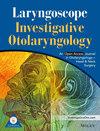The effect of unilateral endoscopic arytenoid abduction lateropexy on swallowing in cases of bilateral vocal fold palsy
Abstract
Objective
Endoscopic arytenoid abduction lateropexy (EAAL) is a minimally invasive surgical technique for the immediate management of bilateral vocal fold palsy (BVFP). Specifically, it achieves a stable and adequate airway by lateralizing the arytenoid cartilage without resecting laryngeal structures. Thus, this study evaluated the effect of EAAL on swallowing in cases of BVFP.
Methods
The participants consisted of 17 adult patients (15 female, 2 male) who underwent unilateral EAAL for BVFP. Swallowing function was evaluated by using the fiberoptic endoscopic evaluation of swallowing (FEES) on the 6th postoperative day and in the 6th postoperative month. The results were assessed by using the pharyngeal residue severity scale (PRSS) and the modified penetration-aspiration scale (mPAS). Additionally, the M.D. Anderson Dysphagia Inventory (MDADI) questionnaire was self-administered during the 6th postoperative month.
Results
Overall, 16 of the 17 patients demonstrated normal swallowing function during the early and late postoperative periods. Moreover, one patient experienced mild fluid aspiration early on, but initially managed it with dietary adjustments and eventually resolved it with a head flexion compensatory maneuver. There was no significant deterioration in swallowing-related quality of life according to the MDADI assessments.
Conclusion
Based on this evaluation of unilateral EAAL, our results confirmed that this procedure is not only a reliable solution for BVFP from the perspective of respiratory function and phonation but also in terms of swallowing quality.
Level of Evidence
4.


 求助内容:
求助内容: 应助结果提醒方式:
应助结果提醒方式:


